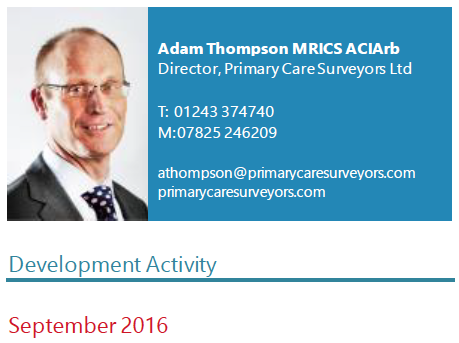
It is generally acknowledged that there has been an underinvestment in primary care infrastructure for several years. The reasons for this are well established, with the focus in recent years having been to ensure continuity of service provision which has consumed an ever-increasing part of NHS budgets against lower tax yields during the austerity following recession.
Whilst Commissioners have been able to be more selective in how services are commissioned, there comes a point at which further efficiencies can only be achieved by a fundamental change as to how services can be delivered. With much of the real estate for primary care being in older, modest premises, the recent announcements by both Jeremy Hunt (Secretary of State for Health) and Simon Stevens (Chief Executive, NHS England) have now explicitly mentioned the need for changes in primary care real estate. The restructuring of primary care infrastructure should facilitate greater efficiencies in how primary care services can be delivered.
Premises funding is currently being offered by way of the Estates & Technology Transformation Fund (ETTF). Applications for funding had to be submitted by 30 June 2016 and these applications are currently being reviewed by NHS England (with CCGs having made their priorities known). The outcomes are due to be published imminently.
The challenge facing these applications is that the funding being offered is by way of capital as opposed to revenue funding, although in some instances NHS England will pay up to 100% of the capital cost of the proposed works for a new medical centre. In return for capital being funded, the rent paid to the Practice will then be deferred (or abated) for a period of as many as 15 years.
One of the criteria for the ETTF is that the proposed works have to be completed and be available for use by 31 March 2019. Given that most construction projects take 10-12 months, this has meant that land will need to be purchased swiftly with planning consent hopefully uncontentious.
The total funding under the ETTF and its previous incarnations (the Primary Care Infrastructure Fund and Primary Care Transformation Fund) is for one billion pounds over a four-year period. By the time this is rolled out to each CCG, and allowing for competition between each CCG area, there is unlikely to be sufficient capital for all the applied-for schemes. In some instances, the NHS has suggested that we use the ETTF timetable to focus minds, but the eventual medical centre is likely to be funded by revenue funding in the traditional sense.
An interesting development would be the publication of the Sustainability and Transformation Plans (STPs) which are seen as being a lynch pin between primary and secondary care in the locality. There has been some recent press coverage concerning the draft STPs and how these mention that there may be a reduction of GP surgeries. The uncomfortable truth is that it is inevitable that some GP surgeries will need to close, but these will be smaller house conversion surgeries where the patient list may easily be dispersed to other nearby practices.
In recent conversations with CCGs, there is generally much greater willingness to engage in discussions concerning new premises. Funding is not easy but CCGs seem to be anxious to discuss how services can be restructured and delivered more efficiently and to point out that there does need to be a change in the infrastructure to bring about greater efficiencies and service delivery.
The viability of new medical centres in terms of achieving sufficient funding (albeit capital or revenue funding) to meet the cost of delivering premises, is a subject that will need careful consideration. With construction costs having increased in recent years as well as land prices in general increasing, it follows that there may need to be an increase in rental levels to make such schemes viable. Thus far the budgetary constraints of CCGs has sometimes made the issue of rent of new premises quite challenging which, combined with District Valuers often looking retrospectively at historic rents and seeking to apply these to proposed new developments, does mean that the viability of new medical centres is doubtful. It has been fortunate that with the long term low level of interest rates, investments yields have similarly been low (which increases the capital value of proposed developments) and this has meant that some schemes have proved to be viable by virtue of low interest rates. However, profit margins for developments have been squeezed and there comes a point where developers will not be inclined to proceed without an adequate return.
There are numerous issues that need to be considered for the viability of delivering new medical centres, such as the impact of VAT and how the medical centre is to be procured and delivered.
Other aspects can improve the viability, such as the inclusion of a pharmacy, and there is also increasing interest from other occupiers seeking to co-locate with GP practices, such as diagnostic service providers, Acute Trusts and private hospitals to run outpatient clinics. These topics will be covered further in future articles.

